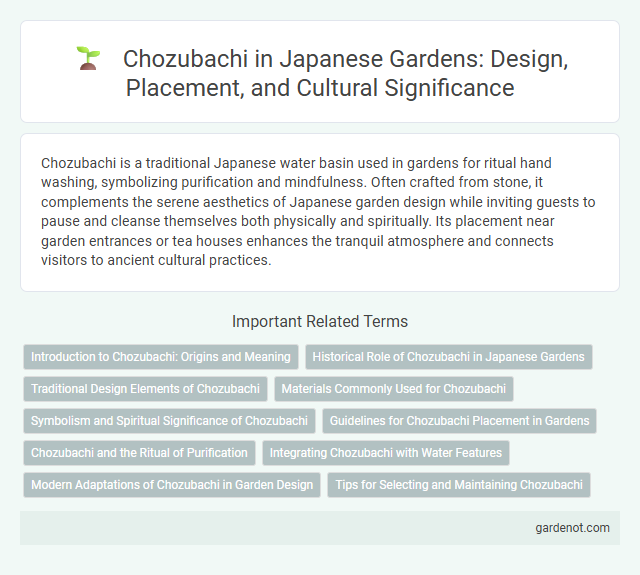Chozubachi is a traditional Japanese water basin used in gardens for ritual hand washing, symbolizing purification and mindfulness. Often crafted from stone, it complements the serene aesthetics of Japanese garden design while inviting guests to pause and cleanse themselves both physically and spiritually. Its placement near garden entrances or tea houses enhances the tranquil atmosphere and connects visitors to ancient cultural practices.
Introduction to Chozubachi: Origins and Meaning
Chozubachi, a traditional Japanese water basin, originated from ancient purification rituals rooted in Shinto practices, symbolizing spiritual cleansing and renewal. Typically crafted from stone, its purpose is to provide visitors with a means to wash their hands and rinse their mouths before entering sacred spaces, reflecting deep cultural reverence for purity. The term "Chozubachi" combines "chozu" (hand water) and "bachi" (basin), emphasizing its functional and symbolic significance within Japanese garden design.
Historical Role of Chozubachi in Japanese Gardens
Chozubachi, traditionally crafted stone basins, played a vital historical role in Japanese gardens as tools for ritual purification before tea ceremonies. These basins exemplify the integration of Shinto and Buddhist purification practices into garden design, symbolizing spiritual cleansing and mindfulness. Positioned near tea houses, the Chozubachi enhances the ceremonial atmosphere while reflecting the garden's aesthetic and cultural values.
Traditional Design Elements of Chozubachi
Chozubachi, a stone water basin used for ritual purification in Japanese gardens, embodies traditional design elements such as natural stone materials, simple geometric shapes, and placement near water sources or bamboo ladles. The aesthetics emphasize wabi-sabi, highlighting rustic simplicity and the beauty of natural imperfection. These features create a serene, meditative atmosphere essential for the authentic Japanese garden experience.
Materials Commonly Used for Chozubachi
Chozubachi, traditional Japanese water basins, are commonly crafted from materials such as granite, stone, and ceramic, valued for their durability and natural aesthetic. Granite offers a rugged texture that weathers gracefully, while ceramic varieties allow for intricate designs and glazes that complement garden themes. Stone, often hand-carved, provides a rustic and timeless quality, enhancing the tranquil atmosphere central to Japanese garden design.
Symbolism and Spiritual Significance of Chozubachi
Chozubachi, traditional stone water basins found in Japanese gardens, embody deep symbolism rooted in purification and spiritual renewal. These basins serve as ritual cleansing stations where visitors wash their hands and mouth before entering sacred spaces, reflecting Shinto and Buddhist principles of cleansing impurities. The deliberate placement of Chozubachi within serene garden settings enhances mindfulness and reverence, fostering a contemplative atmosphere integral to Japanese spiritual traditions.
Guidelines for Chozubachi Placement in Gardens
Chozubachi placement in Japanese gardens should prioritize accessibility near entrances or tea rooms for easy handwashing, reflecting its ritual purification role. The basin must be positioned at a comfortable height, typically around 40-50 cm, to accommodate natural hand posture, enhancing usability without straining. Surrounding elements like stones or bamboo arms should create a harmonious, serene setting, ensuring the chozubachi integrates seamlessly into the garden's aesthetic and spiritual flow.
Chozubachi and the Ritual of Purification
Chozubachi, a stone basin commonly found in Japanese gardens, plays a central role in the ritual of purification known as temizu or chozu. Visitors use the chozubachi to wash their hands and rinse their mouths, symbolizing the cleansing of impurities before entering sacred spaces. This ritual highlights the cultural significance of purity and mindfulness in traditional Japanese garden design and spiritual practice.
Integrating Chozubachi with Water Features
Chozubachi, traditional Japanese stone basins, enhance garden water features by providing a serene focal point for ritual handwashing, symbolizing purification. Integrating Chozubachi with flowing streams or bamboo spouts maintains the aesthetic harmony while promoting natural water circulation. These basins, often paired with surrounding moss and pebbles, create a balanced blend of texture and sound that enriches the tranquility of Japanese garden design.
Modern Adaptations of Chozubachi in Garden Design
Modern adaptations of Chozubachi in garden design incorporate sleek materials such as granite and concrete, blending traditional aesthetics with contemporary style. Designers often integrate LED lighting within these water basins to enhance nighttime ambiance while preserving the ritualistic cleansing function. Innovative shapes and multi-functional elements, including planter combinations and water features, allow Chozubachi to serve both decorative and practical purposes in urban garden spaces.
Tips for Selecting and Maintaining Chozubachi
Selecting a Chozubachi involves choosing natural materials like stone or ceramic to ensure durability and authenticity in a Japanese garden setting. Proper placement near the garden entrance or tea house enhances both functionality and aesthetic appeal, allowing easy access for ritual handwashing. Regular maintenance includes cleaning the basin to prevent algae buildup and checking the water supply system to maintain continuous flow and freshness.
Chōzubachi Infographic

 gardenot.com
gardenot.com